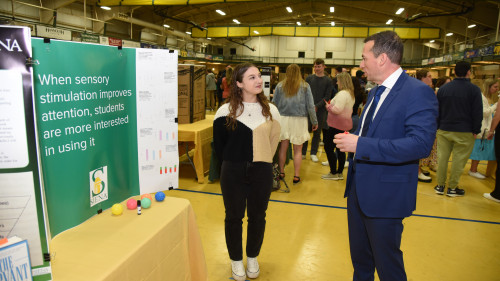
By Kristen Bossio '16
From horror novels to television commercials to young adult literature, the vampire is a timeless creature that has captured people’s attention for generations. Still, the vampire is not just a source of entertainment. The mythical figure can also serve as a powerful educational tool.
Siena College Associate Professor of English, Lisa Nevarez, Ph.D., is the editor of a collection of essays on teaching the figure of the vampire, titled "The Vampire Goes to College: Essays on Teaching with the Undead" and published by McFarland Press. Inspiration for the collection was twofold. Nevarez designed an English Honors seminar on “The Vampire,” and with the support of an Information Literacy Faculty Development Grant, she incorporated student-authored blogs and other platforms for discussion and research into that class. She also realized, through her regular attendance at the national meetings of the Popular Culture Association, that there existed no collective resource through which instructors could share their own pedagogical approaches to teaching the vampire.
"The Vampire Goes to College" is directed mainly towards instructors who teach (or hope to teach) about this fascinating figure. The essays cover topics including, but not limited to, strategies for contextualizing the historical origins of the vampire, incorporating writing instruction, pairing diverse vampire texts, and designing courses ranging from First-Year Seminars to community college learning environments.
“The vampire being a really timeless and diverse figure provides a good medium for talking about sensitive topics. It’s a way to encourage conversation on issues that some of us may find challenging to even think about,” said Nevarez. She has witnessed this not only in her vampire seminar, but in other English classes she has regularly taught over the course of her twelve years at Siena, such as in “The Horror Novel” and “Romantic Literature,” which incorporates a look at the Gothic.
In the vampire seminar, she asked the students to investigate and research certain topics, including animal transfiguration, sexual relationships, ethnicity and race, and vampire slayers, to discover how they have evolved through vampire literature, folklore, film, and other media, and—most importantly—to conjecture as to why. This culminated in individual final research projects, which the students also shared at Academic Celebration Day.
“The vampire transcends time,” said Nevarez, adding that there is a lot more to the figure than “sparkly Edward,” one of the main characters in Stephenie Meyer’s "Twilight" series.
By using the vampire as a teaching tool, Nevarez endeavors to spark student interest in the late eighteenth and early nineteenth century literary origins of the vampire. Throughout its lengthy life span, the vampire reflects the cultural concerns of any given era, as can be observed in poetry and prose and now in various media formats.
Taking a popular figure, such as the vampire, and using it to talk about pressing issues both in today’s world and in the past, can have a profound impact on students. Nevarez hopes that her book will give teachers the tools to help students sink their teeth into literature.



